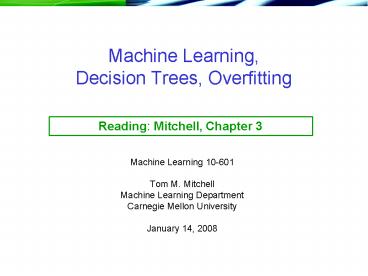Machine Learning, Decision Trees, Overfitting - PowerPoint PPT Presentation
Title:
Machine Learning, Decision Trees, Overfitting
Description:
Title: PowerPoint Presentation Author: Tom M. Mitchell Last modified by: Tom Mitchell Created Date: 1/15/2001 4:39:59 AM Document presentation format – PowerPoint PPT presentation
Number of Views:304
Avg rating:3.0/5.0
Title: Machine Learning, Decision Trees, Overfitting
1
Machine Learning,Decision Trees, Overfitting
Reading Mitchell, Chapter 3
- Machine Learning 10-601
- Tom M. Mitchell
- Machine Learning Department
- Carnegie Mellon University
- January 14, 2008
2
Machine Learning 10-601
- Instructors
- William Cohen
- Tom Mitchell
- TAs
- Andrew Arnold
- Mary McGlohon
- Course assistant
- Sharon Cavlovich
- See webpage for
- Office hours
- Grading policy
- Final exam date
- Late homework policy
- Syllabus details
- ...
webpage www.cs.cmu.edu/tom/10601
3
Machine Learning
- Study of algorithms that
- improve their performance P
- at some task T
- with experience E
well-defined learning task ltP,T,Egt
4
Learning to Predict Emergency C-Sections
Sims et al., 2000
9714 patient records, each with 215 features
5
Learning to detect objects in images
(Prof. H. Schneiderman)
Example training images for each orientation
6
Learning to classify text documents
Company home page vs Personal home page
vs University home page vs
7
Reading a noun (vs verb)
Rustandi et al., 2005
8
Machine Learning - Practice
Speech Recognition
- Supervised learning
- Bayesian networks
- Hidden Markov models
- Unsupervised clustering
- Reinforcement learning
- ....
Control learning
Text analysis
9
Machine Learning - Theory
- Other theories for
- Reinforcement skill learning
- Semi-supervised learning
- Active student querying
PAC Learning Theory
(supervised concept learning)
examples (m)
representational complexity (H)
error rate (e)
- also relating
- of mistakes during learning
- learners query strategy
- convergence rate
- asymptotic performance
- bias, variance
failure probability (d)
10
Growth of Machine Learning
- Machine learning already the preferred approach
to - Speech recognition, Natural language processing
- Computer vision
- Medical outcomes analysis
- Robot control
- This ML niche is growing
- Improved machine learning algorithms
- Increased data capture, networking
- Software too complex to write by hand
- New sensors / IO devices
- Demand for self-customization to user, environment
ML apps.
All software apps.
11
Function Approximation and Decision tree learning
12
Function approximation
- Setting
- Set of possible instances X
- Unknown target function f X?Y
- Set of function hypotheses H h h X?Y
- Given
- Training examples ltxi,yigt of unknown target
function f - Determine
- Hypothesis h? H that best approximates f
13
How would you represent AB ? CD(?E)?
Each internal node test one attribute Xi Each
branch from a node selects one value for Xi Each
leaf node predict Y (or P(YX ? leaf))
14
(No Transcript)
15
ID3, C4.5,
node Root
16
Entropy
- Entropy H(X) of a random variable X
- H(X) is the expected number of bits needed to
encode a randomly drawn value of X (under most
efficient code) - Why? Information theory
- Most efficient code assigns -log2P(Xi) bits to
encode the message Xi - So, expected number of bits to code one random X
is
of possible values for X
17
Entropy
- Entropy H(X) of a random variable X
Specific conditional entropy H(XYv) of X given
Yv
Conditional entropy H(XY) of X given Y
Mututal information (aka information gain) of X
and Y
18
Sample Entropy
19
Subset of S for which Av
Gain(S,A) mutual information between A and
target class variable over sample S
20
(No Transcript)
21
(No Transcript)
22
(No Transcript)
23
Decision Tree Learning Applet
- http//www.cs.ualberta.ca/7Eaixplore/learning/Dec
isionTrees/Applet/DecisionTreeApplet.html
24
Which Tree Should We Output?
- ID3 performs heuristic search through space of
decision trees - It stops at smallest acceptable tree. Why?
Occams razor prefer the simplest hypothesis
that fits the data
25
Why Prefer Short Hypotheses? (Occams Razor)
- Argument in favor
- Fewer short hypotheses than long ones
- ? a short hypothesis that fits the data is less
likely to be a statistical coincidence - ? highly probable that a sufficiently complex
hypothesis will fit the data - Argument opposed
- Also fewer hypotheses with prime number of nodes
and attributes beginning with Z - Whats so special about short hypotheses?
26
(No Transcript)
27
(No Transcript)
28
(No Transcript)
29
(No Transcript)
30
Split data into training and validation
set Create tree that classifies training set
correctly
31
(No Transcript)
32
(No Transcript)
33
(No Transcript)
34
(No Transcript)
35
(No Transcript)
36
(No Transcript)
37
What you should know
- Well posed function approximation problems
- Instance space, X
- Sample of labeled training data ltxi, yigt
- Hypothesis space, H f X?Y
- Learning is a search/optimization problem over H
- Various objective functions
- minimize training error (0-1 loss)
- among hypotheses that minimize training error,
select shortest - Decision tree learning
- Greedy top-down learning of decision trees (ID3,
C4.5, ...) - Overfitting and tree/rule post-pruning
- Extensions
38
Questions to think about (1)
- Why use Information Gain to select attributes in
decision trees? What other criteria seem
reasonable, and what are the tradeoffs in making
this choice?
39
Questions to think about (2)
- ID3 and C4.5 are heuristic algorithms that search
through the space of decision trees. Why not
just do an exhaustive search?
40
Questions to think about (3)
- Consider target function f ltx1,x2gt ? y, where x1
and x2 are real-valued, y is boolean. What is
the set of decision surfaces describable with
decision trees that use each attribute at most
once?































